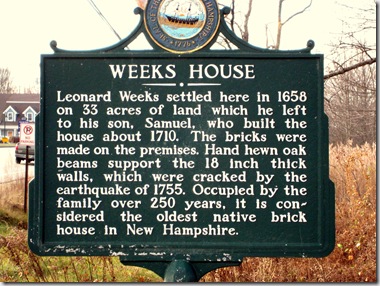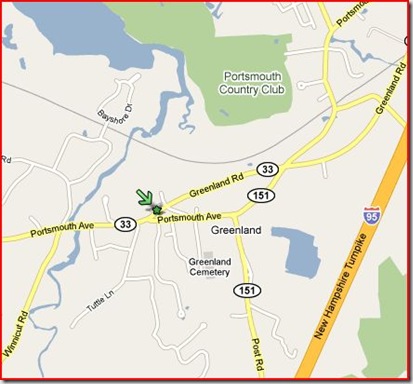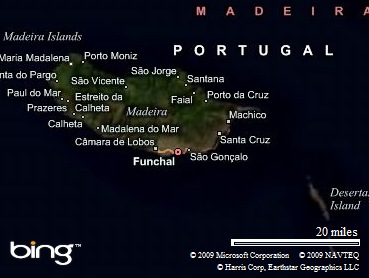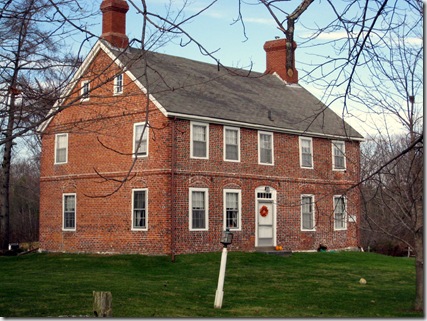Marker Text:
Leonard Weeks settled here in 1658 on 33 acres of land which he left to his son Samuel, who built the house about 1710. The bricks were made on the premises. Hand hewn oak beams support the 18-inch thick walls, which were cracked by the earthquake of 1755. Occupied by the family over 250 years, it is considered the oldest native brick house in New Hampshire.
This Marker was erected in 1976 and is located on the north side of NH 33, about a half mile west of its junction with NH 151.
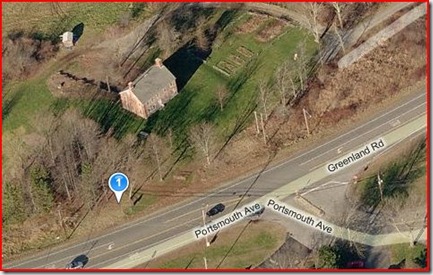 Aerial view, marker location (1) and the Week’s House.
Aerial view, marker location (1) and the Week’s House.
The story of the Weeks house is also the story of the settling of Greenland, NH. A large tract of land here was originally given to Capt. Francis Champernowne, British Nobleman between 1640 and 1644. The original land grants for New Hampshire and Maine were given to Mason and Georges, repevtively and New Hampshire first settled by Thompson and Hilton and. Champernowne was a young boy at the time, but Georges married one of his relatives back in England, and was probably influenced by him to eventually come to New England. (Capt. Francis Champernowne: The Dutch conquest of Acadie p89.)
Champernowne was very loyal to King Charles I who was having some problems keeping his royal subjects in line. There was a Civil War going on back in England. The two main factions were the Royalists that believed in the Divine Right of King’s, and the Parliamentarians that believed in a more representative Commonwealth – this included the Puritans, many of which were in early New England.
As a result, he was busy captaining a ship and harassing Massachusetts Bay colony trade in the Madeira Isles (off the coast of Portugal) for much of the 1640s.
In his absence he hired an agent to take care of his holdings. Additional land grants were given to him as well, and the one in 1655 is the most important for this story:
“In 1655 the town made to him a further grant of three hundred and seventy-five acres of `marsh, meadow, and upland.` This grant was laid out in the same year, and was referred to in conveyances of land in Greenland for more than half a century as Champernowne’s "new farm." …
He lived on his Greenland farm until the month of July, 1657, when he conveyed it to Valentine Hill, upon some agreement with Hill to satisfy a claim of Captain White, and for other considerations. Hill immediately conveyed the farm to Thomas Clarke and William Paddy, merchants of Boston.”
Capt. Francis Champernowne: The Dutch conquest of Acadie p109-111
And so he sold his land in 1657 and moved to Maine where he also had land that had been originally given to his father. He died there in 1686.
Leonard Weeks originally came to New Hampshire around 1648 at the age of 15 on one of Champernowne’s ships, and worked the farm land for him. In 1556 recieved his first land grant in Greenland. Seems our new land owner liked to cuss as well, he was the first person in Greenland ever tried at the county court in Portsmouth in 1660, charged with:
"Swareing by god & Callinge John Hall of Greenland ould dogg & ould Slave & that he would knocke him in the head: this is testifid by Thomas Peverley & Joseph Attkinson."
It cost him 10 shillings. That’ll teach him!
He married and had eight children here, and expanded his land holdings further. Near the end of his days, he bequeathed his property to his second son Samuel Weeks and died a year later in 1707.
Samuel Weeks was a Captain of the Greenland militia, Selectman, and filled many other important city functions for Greenland. He built the Weeks House around 1710…
…and this is what it looks like today (click to enlarge) November, 2009. It’s still a private residence. He died in 1746 but left a beautiful and lasting representation of the early settlers of New Hampshire. Visit the Weeks Brick House web site, and the Greenland Weeks Public Library for all your Greenland History needs.
The marker notes: “Hand hewn oak beams support the 18-inch thick walls, which were cracked by the earthquake of 1755.” I can’t let a tidbit like this go by without checking into it. The Massachusetts Historical Society has some information.
At about 4:30 in the morning on 18 November 1755, a strong earthquake rocked the New England area. Observers reported damage to chimneys, brick buildings, and stone walls in coastal communities from Portland, Maine to south of Boston, Massachusetts. Chimneys were also damaged as far away as Springfield, Massachusetts, and New Haven, Connecticut. The earthquake was felt at Halifax, Nova Scotia, to the northeast, Lake Champlain to the northwest, and Winyah, South Carolina to the southwest. The crew of ship in deep water about 70 leagues east of Boston thought it had run aground and only realized it had felt an earthquake when it arrived at Boston later that same day.
